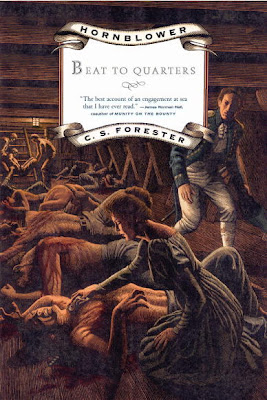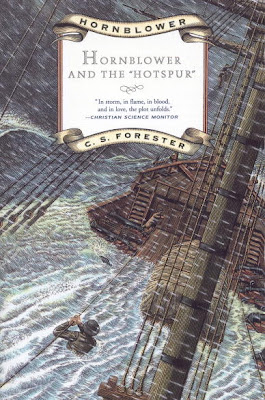
Wednesday, May 27, 2009
FLYING COLOURS by C. S. Forester

Saturday, May 23, 2009
SHIP OF THE LINE by C. S. Forester

Wednesday, May 20, 2009
BEAT TO QUARTERS by C. S. Forester

Monday, May 18, 2009
HORNBLOWER AND THE ATROPOS by C. S. Forester

GIANTS OF LAND, SEA & AIR: PAST & PRESENT by David Peters
Giants of Land, Sea & Air: Past & Present (1986) is a children’s book from the Sierra Club by artist David Peters. It is currently out of print, although copies are not difficult to find. Each page features, as the title suggests, some of earth’s largest land, sea and air creatures, extinct and living, with humans shown for scale. Each creature gets a few paragraphs of description plus its Latin name and taxonomic information.
Thursday, May 14, 2009
HORNBLOWER DURING THE CRISIS by C. S. Forester
Hornblower During the Crisis (1967), also known as Hornblower and the Crisis, is the last Hornblower novel C. S. Forester worked on – he died before he finished it. It fits fourth in the chronology. The book also includes two short stories, “Hornblower’s Temptation” (also known as “Hornblower and the Widow McCool,” and “The Last Encounter.”
Wednesday, May 13, 2009
Hornblower Timeline
According to Mr. Midshipman Hornblower, Horatio Hornblower was born in 1776.
Period Covered - Book - Date of Publication
1793-1798 - Mr. Midshipman Hornblower - 1950
1799 - “Hornblower’s Temptation”*
1800-1803 - Lieutenant Hornblower - 1952
1803-1805 - Hornblower and the Hotspur - 1962
1805 - Hornblower During the Crisis - 1967
1805-1808 - Hornblower and the Atropos - 1953
1808 - Beat to Quarters (The Happy Return) - 1937
1810 - Ship of the Line - 1938
1810-1811 - Flying Colours - 1938
1812 - Commodore Hornblower - 1945
1813-1814 - Lord Hornblower - 1946
1821-1823 - Admiral Hornblower in the
1848 - “The Last Encounter”*
*“Hornblower's Temptation” and “The Last Encounter” are included in Hornblower During the Crisis.
C. S. Forester published three other Hornblower stories:
-“Hornblower and His Majesty” – set in 1812, published in 1940
-“The Hand of Destiny” – set in 1796, published in 1940
-“Hornblower’s Charitable Offering” – set in 1810, published in 1941
Tuesday, May 12, 2009
HORNBLOWER AND THE HOTSPUR by C. S. Forester
Hornblower and the Hotspur (1962) is C. S. Forester’s third Hornblower novel chronologically, tenth by publication. Horatio Hornblower has, more out of pity than anything else, gone ahead and married the rather pathetically devoted Maria, his landlady’s daughter. But
Friday, May 8, 2009
LIEUTENANT HORNBLOWER by C. S. Forester
Wednesday, May 6, 2009
THE NEVERENDING STORY by Michael Ende
The Neverending Story (Die unendliche Geschichte) is a 1979 young adult fantasy novel by Michael Ende, translated from the original German by Ralph Manheim and illustrated by Roswitha Quadflieg. In our world, Bastian, a fat, unpleasant, unloved bookworm of a child, steals a book called The Neverending Story from a shop. This book chronicles the adventures of the child hero Atreyu, who embodies all the virtues that Bastian does not, as he attempts to save the world of Fantastica from total destruction. But their two worlds, as Bastian comes to discover, are connected.
Friday, May 1, 2009
MR. MIDSHIPMAN HORNBLOWER by C. S. Forester
Mr. Midshipman Hornblower is a 1950 novel by C. S. Forester. It is, chronologically, the first book in the eleven-book Hornblower series, although Forester wrote it sixth. It reads and flows considerably more like a sequence of short stories than a novel. In 1794, the young Horatio Hornblower enters the Royal Navy as a midshipman.





